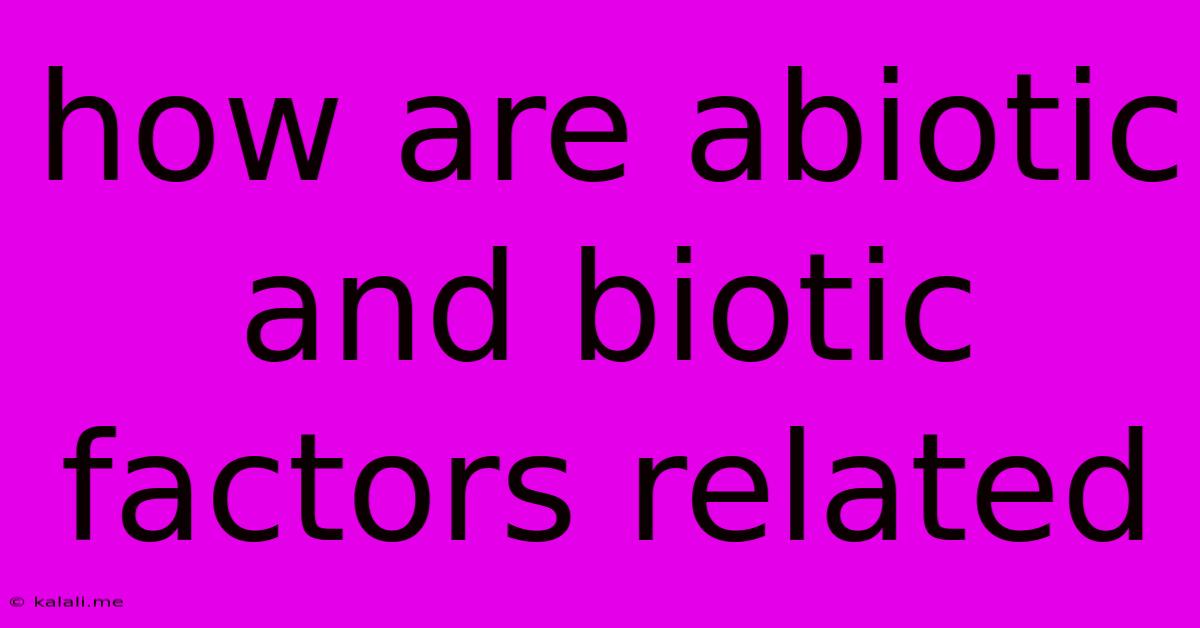How Are Abiotic And Biotic Factors Related
Kalali
May 10, 2025 · 3 min read

Table of Contents
The Intertwined Dance of Abiotic and Biotic Factors: A Look at Ecosystem Dynamics
Meta Description: Discover the intricate relationship between abiotic (non-living) and biotic (living) factors in an ecosystem. Learn how these elements are interconnected and essential for maintaining ecological balance. This article explores various examples and explains the consequences of disruption.
Ecosystems, the vibrant tapestry of life on Earth, are not simply collections of organisms. They are complex, interwoven networks where living and non-living components constantly interact and influence one another. Understanding this intricate relationship between abiotic and biotic factors is crucial to grasping the functioning and stability of any ecosystem, from a lush rainforest to a barren desert.
What are Abiotic and Biotic Factors?
Let's define our terms:
-
Abiotic factors encompass the non-living components of an ecosystem. These include physical and chemical elements like:
- Temperature: Influencing metabolic rates and species distribution.
- Sunlight: Providing energy for photosynthesis and driving many ecological processes.
- Water: Essential for all life, impacting hydration, nutrient transport, and habitat availability.
- Soil: Providing nutrients and support for plants, impacting overall ecosystem structure.
- Air: Containing essential gases like oxygen and carbon dioxide, crucial for respiration and photosynthesis.
- pH: Affecting nutrient availability and organismal survival.
- Salinity: Determining which species can thrive in a particular environment (e.g., freshwater vs. saltwater).
- Topography: Influencing microclimates, drainage patterns, and habitat diversity.
-
Biotic factors, on the other hand, represent the living organisms within an ecosystem. This includes:
- Producers (autotrophs): Plants and algae that convert sunlight into energy through photosynthesis.
- Consumers (heterotrophs): Animals that obtain energy by consuming other organisms. This category includes herbivores, carnivores, and omnivores.
- Decomposers (saprotrophs): Bacteria and fungi that break down dead organic matter, recycling nutrients back into the ecosystem.
The Interdependence: How Abiotic and Biotic Factors Interact
The relationship between abiotic and biotic factors is one of profound interdependence. Abiotic factors set the stage, determining which organisms can survive and thrive in a particular environment. Biotic factors, in turn, modify and shape their abiotic surroundings. Here are some key examples:
-
Plants and Sunlight: The amount of sunlight available directly influences plant growth and distribution. Shaded areas will support different plant communities compared to sunny areas. This, in turn, affects the animals that rely on those plants for food and shelter.
-
Temperature and Animal Behavior: Temperature dramatically influences animal behavior, such as hibernation or migration. Extreme temperatures can even lead to population decline or extinction.
-
Water Availability and Plant Adaptations: Plants in arid environments have evolved adaptations like water storage tissues (cacti) or deep root systems to cope with limited water availability. These adaptations shape the entire ecosystem, influencing the animals that can live there.
-
Soil Composition and Plant Nutrition: The nutrient content of the soil directly impacts plant growth and health. This impacts the entire food web, as the health of plants directly affects the organisms that feed on them.
-
Decomposers and Nutrient Cycling: Decomposers play a critical role in breaking down organic matter, returning essential nutrients to the soil. This replenishes the abiotic resources vital for plant growth, completing the cycle.
Consequences of Imbalance: The Importance of Maintaining Equilibrium
Any significant alteration in abiotic or biotic factors can trigger cascading effects throughout the entire ecosystem. For example:
-
Climate Change: Increased temperatures and altered rainfall patterns are drastically impacting ecosystems worldwide, leading to habitat loss, species extinctions, and disruptions to food webs.
-
Pollution: Introduction of pollutants into the environment can poison organisms, contaminate water sources, and disrupt nutrient cycles, severely impacting both biotic and abiotic components.
-
Habitat Destruction: Deforestation and urbanization directly destroy habitats, affecting countless species and altering the abiotic conditions of the area.
Understanding the intricate interplay between abiotic and biotic factors is not just an academic exercise. It's essential for effective conservation efforts, sustainable resource management, and predicting the impacts of environmental change. Maintaining the delicate balance within ecosystems is paramount for the health of the planet and the future of all living things.
Latest Posts
Latest Posts
-
How Much Is 50 Gallons Of Water
Jun 30, 2025
-
How Many Laps Around A Football Field Is A Mile
Jun 30, 2025
-
The Ability To Say Clever And Funny Things
Jun 30, 2025
-
How Many Cups Are In A Pound Of Lard
Jun 30, 2025
-
Why Did Jerry Thompson And Kelly Nelon Divorce
Jun 30, 2025
Related Post
Thank you for visiting our website which covers about How Are Abiotic And Biotic Factors Related . We hope the information provided has been useful to you. Feel free to contact us if you have any questions or need further assistance. See you next time and don't miss to bookmark.